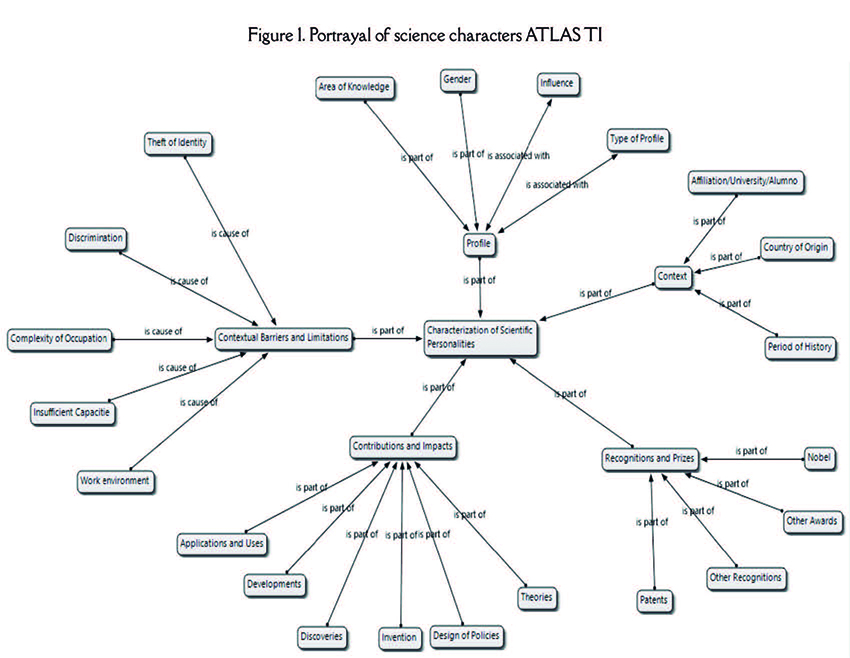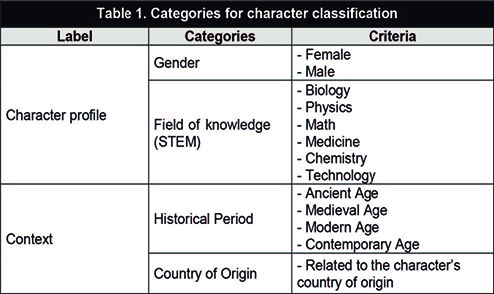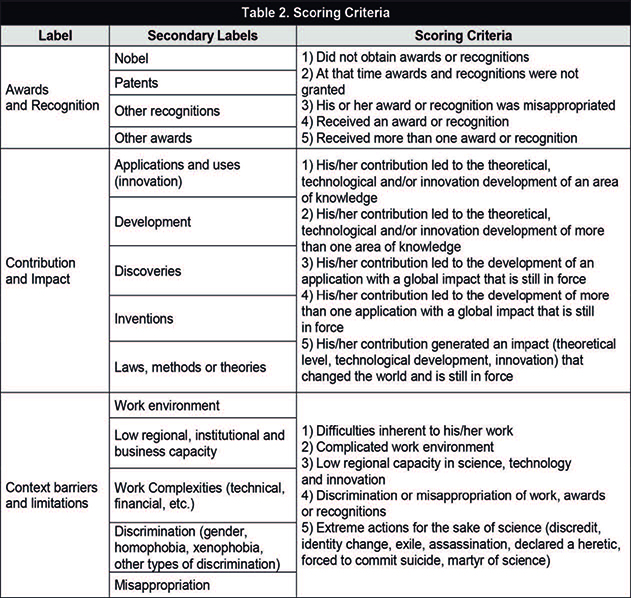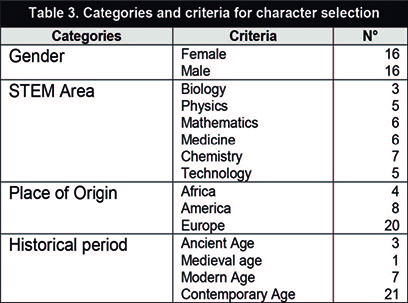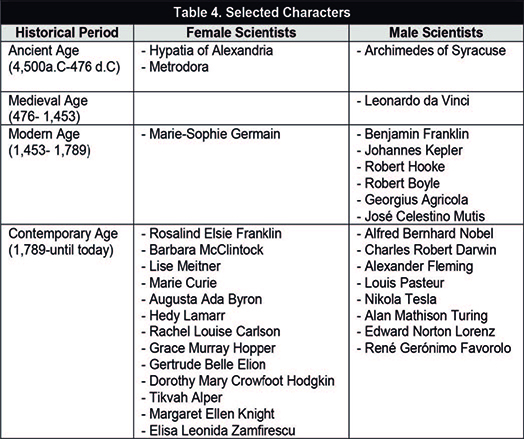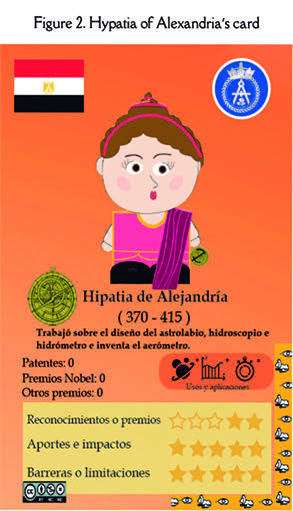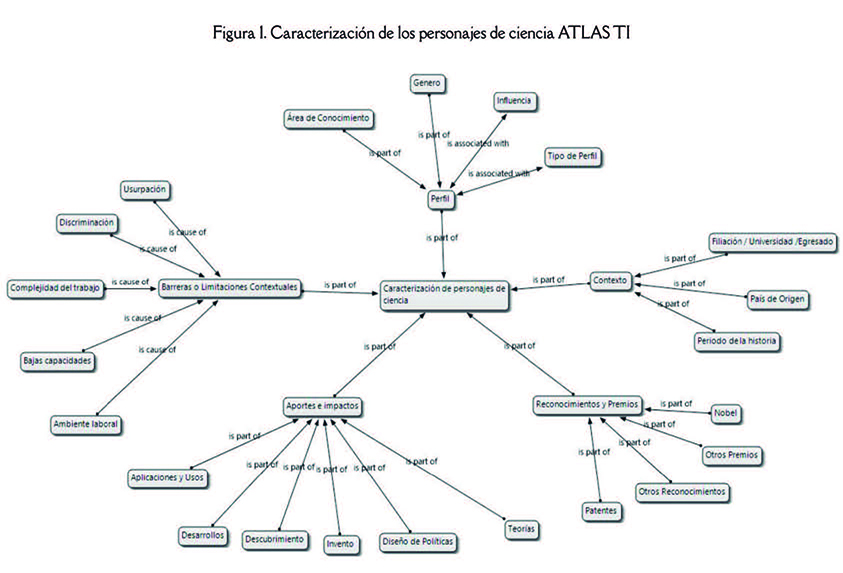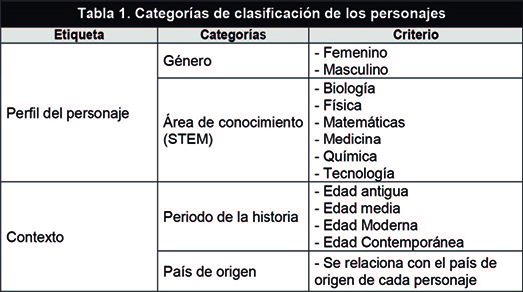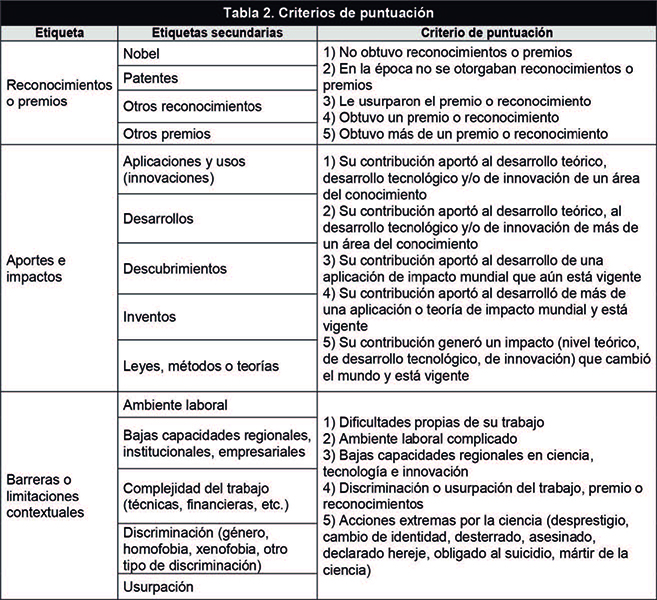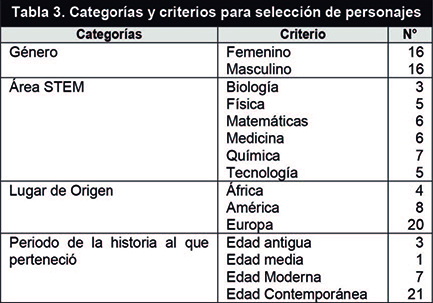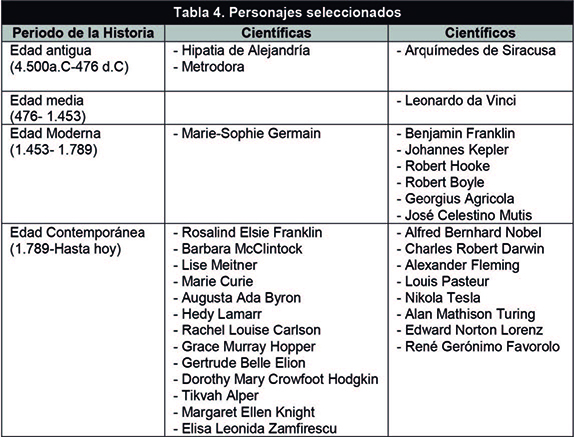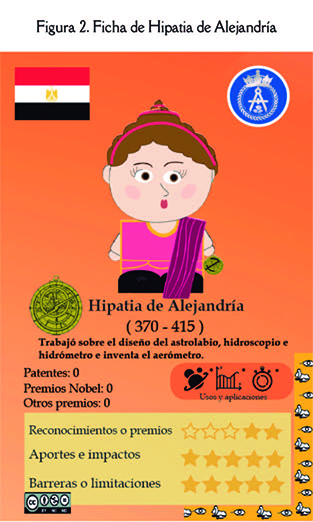Pulsa aquí para ver la versión en Español (ES)
Abstract
Although at present there are academic strategies for scientific dissemination, it is still a challenge for the general population to access quality information that is reliable, easy to understand and motivational towards science. This article proposes an image-based educational scientific dissemination tool with the goal of bringing children closer to science, through the recognition of relevant characters and their contributions. The study was developed along three stages. The first and second were conducted through a qualitative analytical approach with an interpretative perspective, using a documental method, with a review and analysis technique. During the first stage, a review and selection of studies related to scientific dissemination for children was conducted. The second one focused on the identification and selection of scientific characters, through the establishment of categories and criteria. The third stage relates to the design of outstanding characters’ biographical cards. The main contribution of this proposal is the assembly of a semantic network to portray a completed character profile, time context, place of origin, contributions, impacts, acknowledgements or prizes, as well as limitations or difficulties in context. Therefore, a mean of disclosure was devised through cards with a highly graphic and animated content regarding scientific characters sized in a gaming strategy called ‘Sapiencia’, a ludic and motivational learning tool.
1. Introduction
Society is facing increasing challenges in terms of capacity-building in science, technology and innovation in the face of technological, economic, environmental, political and social change. Faced with this context, children must be encouraged to develop capacities that will enable them to recognize and become involved in the progress of the globalized world. The demands of a sustainable society, megatrends (Lay-Arellano, Salas, & al.., 2016), artificial intelligence and its contribution to Industry 4.0, geopolitical changes, among other aspects require citizens with new thought patterns, more sophisticated skills and abilities (Gidley, 2010) in different aspects, both scientific, technological, regulatory and business-related, among others (Jerman, Peji?-Bach, & Bertoncelj, 2018). They also need high levels of education and accessibility to information, allowing them to understand the use of resources and develop new approaches to change, i.e. a critical and participatory citizenship (Díez-Gutiérrez & Díaz-Nafría, 2018).
Within the trends that generate these new dynamics we can highlight how the knowledge economy has led to a need to create an innovative environment in countries with a knowledge-based economy (Olaya-Escobar, Berbegal-Mirabent, & Duarte, 2014). Thus, the strategies that enable the transformation, transfer and appropriation of knowledge and technology have focused on the articulation of the three actors that make up national innovation systems: universities, as knowledge generators; companies, which apply that knowledge to offer new and better solutions to society's needs; and finally the state, in charge of regulating and encouraging transfer policies (Etzkowitz & Leydesdorff, 2000).
Thus, the dissemination of science becomes a determining aspect to meet societal challenges in a context that is continually changing. In this setting, children are key to create new co-existence lessons because of their abilities, level of environmental awareness, creativity and ease of learning. Some authors recognize that generating learning spaces for children where there is interest in science, technology, research and innovation is fundamental in the context of 21st century education. Evidence suggests that the school stage is ideal for awakening and maintaining vocational interest in disciplines such as science, technology, engineering and mathematics (STEM) (Ocumpaugh, San Pedro, Lai, Baker, & Borgen, 2016).
Based on the previous context and the changes involved in strengthening the capacities and skills of citizens and specifically those of children to face and take advantage of current challenges, this article proposes an educational tool for scientific dissemination, based on visual communication to bring children closer to science. This work is organized in five parts: the first, aimed at the contextualization based on the literature and theoretical references related to strategies for science learning and motivation in children. The second, focused on the identification and selection of scientific characters, and the construction of a database to compile relevant information about each character and to identify labels, categories and criteria. The third part is dedicated to the design of an outreach strategy based on the creation of cards about outstanding figures in the scientific field. The fourth section covers the analysis of results, and the fifth and final part offers conclusions and recommendations.
1.1. Strategies for science education and motivation in the child population
At a global level, initiatives have been developed to encourage interest in science. In the United States, teachers have been urged to integrate scientific and engineering practices in science teaching, promoting learning in children and motivating them towards science activities (Guzey, Moore, Harwell, & Moreno, 2016). In Germany, the concept of ‘Bildung’ has been applied to refer to reflective actions, self-education, citizenship training and responsibility for the subject from a proposal of transformative learning around scientific knowledge (Sjoestroem, Frerichs, Zuin, & Eilks, 2017). From a different perspective, Bevan (2017) proposed ‘Doing’ as a productive way of teaching and learning science, directing it to the design of physical and virtual parts related to STEM areas (Science, Technology, Engineering & Mathematics), seeking to encourage creativity and design in science and engineering practices. Thus, experimentation, investigation, interpretation, discussion and evaluation in spaces of scientific training classes, allows schoolchildren to have a positive attitude towards STEM areas (Bogdan & Greca, 2016). Currently, the need to prepare primary students under the STEM approach is strong, and requires implementing technology in learning experiences; therefore, STEM-based pedagogical units are proposed, based on research that can be implemented in existing programs, addressing the creation of new didactic strategies that meet learning needs, where interactive designs and participation are essential (Schmidt & Fulton, 2016).
These 21st century learning strategies for children are developed taking into account technology, new media and information and the different ways of relating to each other. Allison and Goldston (2018) found in their research that scientific activities are enriched by multi-literacies and scientific practices. It is understood as a new literacy proposal in which the use of language must be considered according to the different social and cultural situations, developed in technologies and the media, connecting them with an active participation on the part of the child in tying knowledge to the context. In addition, Roth and Lee (2004) propose a scientific literacy based on daily life, that is, an approach to the scientific world from the family, the community and its problems, with an emphasis on showing science as something close and with multiple possibilities outside of school.
Castro et al. (2015) argue that there should be an environment that promotes scientific literacy and fosters research, highlighting students’ strengths and identifying needs that lead to the application of concepts to everyday life and the understanding of nature on the basis of science, thus achieving the promotion of transferable skills and management of technological tools through strategies related to games and social networks; particularly successful activities in young people who are not interested in STEM areas (Gilliam, Jagoda, Fabiyi, Lyman, Wilson, Hill, & Bouris, 2017).
In his ‘the three rings ‘model, Renzulli (1978) indicates that giftedness is a condition that can be developed if there is an appropriate interaction between the person, his/her environment or particular area of work. This model proposes ‘the grouping of traits that characterize highly productive people’ and identifies three interrelated traits that define a gifted individual. These are above average overall ability, high level of commitment and motivation, and high level of creativity.
Previous studies show that children's motivation towards scientific knowledge is important to develop their learning and critical spirit, so that they can explore the world around them through research (Campanario, 1999) and can think about and propose possible solutions to problems in their context, thus, stimulating the generation of ideas, creativity and the ability to propose solutions; these are key elements in learning, and fundamental elements to promote in children the traits that characterize highly productive people.
There are countless activities to generate motivation for science such as: thematic camps, which evidenced that ‘students need to be exposed to diverse scientific experiences during their learning process, in formal or non-formal educational spaces, so that they can develop a more realistic and general image of scientists and understand their role and function in society’ (Vendrasco, Gallardo, Guzmán, & Santibáñez, 2017: 1683). On the other hand, there is role-play, which has allowed students to advocate their positions within the dynamics of the game, discuss and reflect from the information provided (Agell, Soria, & Carrió, 2015). Another activity consists of didactic sequences in non-conventional spaces such as scientific and technological museums (Cardona-Vásquez, Correa-Magaña, Sánchez, & Ríos-Atehortúa, 2017). Within this set of activities, the work of Scogin (2016) stands out. Using an interactive platform, he managed to get science students to work on projects within their classrooms, in collaboration with scientific mentors from all over the world through the Internet. His study determined that student motivation is fundamental to the success of the program and this was achieved through scientific practice via experiments and contact with scientists who were in permanent interaction with them addressing concerns and encouraging them in the process. This set of experiences on the web has proven to be successful and has received international recognition (Scogin, 2016). Price et al. (2016), after involving play in science learning, showed an improvement in attitudes towards science, strengthening the ability to identify biological systems and their functioning, based on a methodology using educational charts as a learning tool; thus, demonstrating that these didactic strategies help improve student performance over traditional methods. The evaluation results of the educational card game showed that students consider the game in general very satisfactory as a complementary strategy to reinforce the knowledge and skills acquired (Gutierrez, 2014).
Within the strategies to bring children closer to science, there were also those based on the inspirational component achieved through life stories that can become a point of connection between the present and the past and a way to study and understand the changes and the people who have made it possible. Recognizing that there are people who have made great contributions throughout history can be a great motivational reference. Within these experiences, the work of Hwang (2015) who analyzed motivation towards natural sciences, after working with the biography of nine scientists in this area, stands out. This research shows that students achieve greater motivation and attitudes towards learning science through activities that generate interaction, promote creativity and break with the traditional way of teaching. In this regard, one might think that ‘if an individual is interested in science and has an enriched learning environment, he/she might be interested in science in the future’ (Castro-Rojas, Acuna-Zuniga, & Fonseca-Ugalde, 2015: 722). However, within this context of experiences and strategies the use of images has been identified as a means to achieve: a) The comprehension of abstract contents that are difficult to interpret (Otero, & Greca, 2004); b) The motivation to learn and deepen with complementary readings (Alonso-Tapia, & Vergara, 2005); c) The presentation of new concepts; d) The promotion of the recollection of the contents learned and taught (Llorente-Cámara, 2000); e) The cultivation of authentic communication in the classroom and related to daily life; f) The stimulation of the imagination and expression of emotions; g) The activation of previous knowledge (Rigo, 2014); h) The curiosity to approach scientific subjects, which also helps in the understanding of areas such as astronomy (Lee & Feldman, 2015).
1.2. Purpose and objectives
The object of this work is the design of an educational tool for scientific dissemination, based on highly graphic biographical cards and a game as a tool to consolidate the motivational play strategy. The purpose is to bring children (7 to 10 years old) closer to science through the recognition of relevant characters and their contributions. This is achieved through the construction of a semantic network for the description of the character according to his/her profile, place of origin, time and context in which he/she lived, his/her contributions and impacts, recognitions or awards and contextual barriers and limitations to which he/she was exposed.
2. Materials and Method
This research was carried out in three phases. The first and second by means of an interpretative qualitative approach based on the analysis of content as a method. The first phase involves the review and selection of documents related to the topic of scientific dissemination for children. The second focuses on the identification and selection of scientific characters, which have been considered geniuses because their contributions have had universal impact and have been a reference point in the field of knowledge (Gardner, 1993). The third consisted of the strategy design based on the construction of biographical cards and the game ‘Sapiencia’ as a ludic and motivational tool.
2.1. Systematic literature review
The review and selection of documents related to the topic of scientific dissemination for children was carried out using Scopus and Web of Science as the main databases, using the keywords: ‘scientific education’, ‘diffusion or appropriation of science’, ‘science for children’, ‘play and science’, ‘game and learn’ and ‘investigation for children’. From these, the search equation was proposed, which allowed the collection of 317 articles related to the design and practice of non-conventional science learning strategies. The organization and analysis of the documentation was conducted using the bibliographic reference manager Mendeley.
Among the unconventional dissemination strategies that seek to bring children closer to science through the recognition of scientists, we can highlight those related to collectible cards such as: a) ‘Collectible cards’; the United States Patent and Trademark Office (USPTO) launched a series of collectible cartoon cards of inventors to recognize patent holders of various origins (https://bit.ly/2Sppx4O). There are also card games: b) ‘Dones científiques, 30 segles de desigualtat’ is a deck that pays tribute to science pioneers and makes their work visible (Roca, Moreno-Parejas, & Laporta, 2017); c) ‘Top female scientists’ is a card game that seeks to pay tribute to the work done by women in the field of science throughout history (Wakeford & Clark, 2018); d) ‘Women in science’ offers models for young people to encourage them to study science careers; through the game, you can learn about the contributions of female scientists (Charles & Fries, 2015).
2.2. Identification and selection of characters
For this phase, a database was built that compiled information on 374 characters and involved the assignment of labels, categories and criteria for their classification and subsequent selection. The information was collected through articles on the web oriented towards the recognition of scientific personalities such as: a) Women with science, a blog about women scientists. This is part of the science dissemination activities of the Chair of Scientific Culture that seeks to promote scientific and technological knowledge in Basque society; b) The USPTO which has generated spaces for the dissemination of scientific and technological knowledge for children, young people, elementary and secondary school teachers; c) ‘Lifeder’, a site specialized in psychology, personal development and general health; d) Cognovisual which has a space called ‘Invisible Women’, made up of a sample of posters about the life, challenges and contributions of women who made valuable contributions to humanity's knowledge. Additionally, there are academic works, like the one by Gutiérrez (2017) who seeks to highlight the work of women who have been inventors in order to encourage them to consider engineering as their profession. In his book (2012), Claramunt compiles life stories of women dedicated to science emphasizing their contributions and the problems they faced. Roca and others (2017) present a proposal in which they emphasize the importance of learning by playing through a deck of cards with 52 characters, approached from pedagogy and didactics.
2.3. Card and game design as a ludic tool
The last stage was dedicated to the design of highly graphic cards about outstanding people in the scientific field, highlighting the following elements: the profile and context of the character, their contributions to knowledge and impacts on technological development, and recognitions or awards that were granted and contextual barriers or limitations that faced. From the cards, the game ‘Sapiencia’ was proposed as a ludic and motivational tool through the recognition of relevant characters and their respective contributions to science.
3. Results
With the documentation compiled, a qualitative information analysis was performed using ATLAS TI in order to conduct an exploratory analysis of contents and generate the semantic network, which made it possible to identify the labels that give rise to the categories and selection criteria. Figure 1 shows the semantic network generated and the categories and criteria, according to the terms of greatest relevance in the analyzed documents.
From the semantic network, five main labels were established, which in turn were divided into secondary labels (Figure 1). The first one relates to the character's profile; it has secondary labels such as gender, profile type, influence and area of knowledge. The second is related to the period of history in which he/she lived, country of origin and institution to which the character belonged. The third relates to the contributions or impacts generated by the character and it subdivides into: applications and uses, developments, theory and law proposal, discoveries, inventions and policy design. The fourth is related to awards and recognitions: Nobel Prize, patents received, Fields Medal, Letterstedt Prize, Davy Medal, Matteucci Medal, Willard Gibbs Prize, among others. The fifth and final one relates to barriers and limitations in complicated work environments, low regional scientific and technological conditions, work complexity, discrimination and misappropriation of work and/or recognitions.
Based on the labels from the semantic network determined through document analysis with ATLAS IT and recurrence of terms, the categories and scoring criteria were selected. Table 1 shows the selected categories which enable the characters to be classified and grouped by common characteristics. Taking into account the most relevant labels for the purpose of this work, four categories were determined: gender, STEM area of knowledge, country of origin and historical period.
On the other hand, Table 2 shows the criteria that enable each character to generate points. Three criteria were determined, assessed on a scale of 1 to 5, with 1 being the lowest and 5 the highest for each criterion. The first is related to the recognitions or awards granted to the character, the second is related to contributions and impacts, and the third is related to the contextual barriers or limitations faced by the character throughout his or her career (Table 2 for details). On the third column of Table 2, the evaluation criteria for assigning the score are listed.
Table 3 shows the proportion by category of the 32 characters selected to pilot test the bibliographic cards. As shown in Table 3, the selection of characters was performed taking into account the categories identified. Initially the characters of STEM areas were selected from the 374 characters of the database, leaving 219 who belong to one of the professions related to these areas. The second factor that was considered was a date of death longer than 10 years, which reduced the sample to 120 characters. The third factor was the historical period to which the character belonged, while maintaining the proportion of men and women and lastly ensuring that there were representatives from different regions. Table 4 shows the list of characters selected according to their gender and historical period.
The last stage was the design of biographical cards for the characters. These were made using Adobe Photoshop, Indesign and Illustrator. Figure 2 shows the design of the card, with an example of one of the 32 cards, which corresponds to ‘Hypatia of Alexandria’. The center shows the image of the character, her name, date of birth and death, a brief description and symbol of her work. Attached are symbols of the most representative uses and applications to which she contributed. The characters were portrayed by means of geometric figures, taking as a reference their main features to recreate their image in an animated and simple way; the color of the cards was used to identify the gender, green for male scientists and orange for female scientists. Regarding the category related to STEM areas, different color logos were designed with symbols alluding to the professions; these are presented in the upper right corner. On the other hand, in the lower right corner, there is a border of a different color with symbols of the historical period in which the character lived. The origin of the character is represented by each country's flag. Finally, the criteria were represented by star ratings and the number of awards or recognitions received by the character.
‘Sapiencia’ is a card game featuring scientists, details of their work, context and the period in which they lived. The protagonists of the cards belong to STEM areas. There are representatives from various regions, different historical periods and gender parity. The game is based on the categories defined in Table 1 in order to select a comparable element between characters and scoring criteria from Table 2 as a discard parameter. Details, game rules and cards can be downloaded from the ‘Dissemination of Science’ blog (https://bit.ly/2tJo3Za). The suggested age range for play is from 7 to 10 years of age.
4. Discussion and conclusions
Learning over time has been organized around the concept of sharing, similar to board games; however, new technologies have intervened in these spaces. The idea is to highlight the need to strengthen the spaces for interaction and interest in science on the part of children in order to provide them with the necessary tools to face a technological world based on the appropriation of science. It is therefore necessary to inspire children by acknowledging science-relevant characters and their contributions in a pleasant, easy and motivating way. The fundamental contribution of this work is the proposal of a semantic network for the portrayal of characters through their profile, their context in terms of the period and place in which they lived, along with their contribution and the impact of their work, recognitions or awards, plus barriers and contextual limitations. All this supported by the creation of a database with 374 characters.
As mentioned throughout the article, images are important resources for the teaching-learning process because they facilitate the understanding of abstract contents, generate motivation and a desire to deepen knowledge, improve memory, aid in the acquisition of new knowledge and foster curiosity in dealing with scientific subjects. As pointed out by several authors, educational images should be designed according to the objectives of the teaching-learning process. Aligned with this approach, this work proposes a visual communication strategy designed to raise awareness of outstanding figures considered geniuses in the world of science through didactic material. This material was designed with relevant information on the contributions of the characters and their recognitions through simple images that allow a quick association with their contributions. The contribution of this work is evident in two aspects: characterization of animated scientific characters highlighting them through allegorical details of their work, context and period in which they lived, as well as developments and postulates of their work. All this was done preserving criteria of pleasant, simple and colorful figures that allow children to identify with them. The other contribution focuses on the design of standardized biographical cards enriched with information about the characteristics of the character and designed with high graphic content that allows the assimilation of information in an easy and pleasant way. Academic discussions and debates focus on new technologies, but we should not leave out spaces for academic and social sharing, the proposal of collectible cards provides information in a very short reading time, so that children know, internalize and participate in scientific knowledge through play. Symbols, icons and graphic representations of the scientific world are the components with which scientific curiosity is to be motivated and generated.
Finally, the contribution at this point is a proposal for play with the ‘Sapiencia’ cards. The quantity and quality of information and the design of the cards generates great versatility, allowing children to invent their own games and teachers to use them as a support tool in workshops or other classroom activities.
This article is part of the first phase of the research project related to the dissemination and appropriation of knowledge, which focused on proposing educational dissemination strategies and tools to motivate children to take an interest in science; however, it would be important as future work to develop an empirical study to validate the effectiveness of the proposed strategies. Likewise, this methodological approach can be used to deal with didactic material on characters of interest from other areas of knowledge such as social sciences, arts, administrative sciences, among others. On the other hand, this work can be a reference for researchers interested in the impact of ludic strategies for the understanding of learning.
Funding agency
This work is the result of the research project: ‘Strategies for dissemination and appropriation of Science, Technology and Innovation and its articulation with the consolidation of Smart Cities’ by Los Libertadores University Foundation (DIR-001-18).
References
Agell, L., Soria, V., & Carrió, M. (2015). Using role play to debate animal testing. Journal of Biological Education, 49(3), 309-321. https://doi.org/10.1080/00219266.2014.943788
Allison, E., & Goldston, M.J. (2018). Modern scientific literacy: A case study of multiliteracies and scientific practices in a fifth grade classroom. Journal of Science Education and Technology, 27(3), 270-283. https://doi.org/10.1007/s10956-017-9723-z
Alonso-Tapia, J., & Vergara, A.I.E. (2005). La orientación escolar en centros educativos. Madrid: Ministerio de Educación. https://bit.ly/2tMqtGI
Bevan, B. (2017). The promise and the promises of making in science education. Studies in Science Education, 53(1), 75-103. https://doi.org/10.1080/03057267.2016.1275380
Bogdan, T., & Greca, I.M. (2016). Modelo interdisciplinar de educación STEM para la etapa de Educación Primaria. III Simposio Internacional de Enseñanza de Las Ciencias SIEC. https://bit.ly/2TzlBQX
Campanario, J.M. (1999). La ciencia que no enseñamos. Enseñanza de las Ciencias, 17(3), 397-410. https://bit.ly/2HnGriH
Cardona-Vásquez, M., Correa-Magaña, M., Sánchez, Y.V., & Ríos-Atehortúa, L.D. (2017). Actitudes hacia la ciencia en el preescolar mediante la implementación de una secuencia didáctica en un museo. TED: Tecné, Episteme y Didaxis, 2(42). https://doi.org/10.17227/01203916.6966
Castro-Rojas, M.D., Acuña-Zúñiga, A.L., & Fonseca-Ugalde, E. (2015). The Costa Rica GLOBE (Global Learning and Observations to Benefit the Environment) project as a learning science environment. Journal of Science Education and Technology, 24(6), 721-734. https://doi.org/10.1007/s10956-015-9547-7
Charles, A., & Fries, B. (2015). Women in science-card game | Indiegogo. https://bit.ly/21NzlGD
Claramunt-Vallespi?, R.M., & Claramunt-Vallespi?, T. (2012). Mujeres en ciencia y tecnología. Madrid: Universidad Nacional de Educación a Distancia. https://bit.ly/2GYWhQt
Díez-Gutiérrez, E., & Diáz-Nafría, J. (2018). Ubiquitous learning ecologies for a critical cybercitizenship. [Ecologías de aprendizaje ubicuo para la ciberciudadanía crítica]. Comunicar, 54, 49-58. https://doi.org/10.3916/C54-2018-05
Etzkowitz, H., & Leydesdorff, L. (2000). The dynamics of innovation: From National Systems and «Mode 2» to a Triple Helix of university-industry-government relations. Research Policy, 29(2), 109-123. https://doi.org/10.1016/S0048-7333(99)00055-4
Gardner, H. (1993). Creando mentes: Una anatomía de creatividad vista desde las vidas de Freud, Einstein, Picasso, Stravinsky, Eliot, Graham y Gandi. Nueva York: Basic Books.
Gidley, J.M. (2010). Globally scanning for «Megatrends of the Mind»: Potential futures of futures thinking. Futures, 42(10), 1040-1048. https://doi.org/10.1016/j.futures.2010.08.002
Gilliam, M., Jagoda, P., Fabiyi, C., Lyman, P., Wilson, C., Hill, B., & Bouris, A. (2017). Alternate reality Games as an Informal Learning Tool for Generating STEM Engagement among underrepresented youth: A qualitative evaluation of the source. Journal of Science Education and Technology, 26(3), 295-308. https://doi.org/10.1007/s10956-016-9679-4
Gutiérrez, A.F. (2014). Development and effectiveness of an educational card game as supplementary material in understanding selected topics in biology. CBE Life Sciences Education. https://doi.org/10.1187/cbe.13-05-0093
Gutiérrez-Pereda, I. (2017). Mujeres Inventoras, Mujeres Ingenieras. Tesis de Maestría. https://bit.ly/2UbTJCt
Guzey, S.S., Moore, T.J., Harwell, M., & Moreno, M. (2016). STEM: Integration in middle school life science: Student learning and attitudes. Journal of Science Education and Technology, 25(4), 550-560. https://doi.org/10.1007/s10956-016-9612-x
Hwang, S. (2015). Making sense of scientific biographies: Scientific achievement, nature of science, and storylines in college students’ essays. Journal of Biological Education, 49(3), 288-301. https://doi.org/10.1080/00219266.2014.943791
Jerman, A., Peji?-Bach, M., & Bertoncelj, A. (2018). A bibliometric and topic analysis on future competences at smart factories. Machines, 6(3), 41. https://doi.org/10.3390/machines6030041
Lay-Arellano, I.T., Salas, M., Estela, R., Martínez-de-la-Cruz, N.L., Ruiz-Aguirre, E.I., García-Quezada, M.F., … González- Navarro, M. (2016). Educación y cultura en ambientes virtuales. https://bit.ly/2UbyTTD
Lee, H., & Feldman, A. (2015). Photographs and classroom response systems in middle school astronomy classes. Journal of Science Education and Technology, 24(4), 496-508. https://doi.org/10.1007/s10956-014-9539-z
Llorente-Cámara, E. (2000). Imágenes en la enseñanza. Revista de Psicodidáctica, (9), 119-135. https://bit.ly/2U7yhyq
Ocumpaugh, J., San-Pedro, M.O., Lai, H.Y., Baker, R.S., & Borgen, F. (2016). Middle school engagement with mathematics software and later interest and self-efficacy for STEM careers. Journal of Science Education and Technology, 25(6), 877-887. https://doi.org/10.1007/s10956-016-9637-1
Olaya-Escobar, E.S., Berbegal-Mirabent, J., & Duarte, O.G. (2014). Desempeño de las oficinas de transferencia universitarias como intermediarias para la potencialización del mercado de conocimiento. Intangible Capital, 10(1), 155-18. https://doi.org/10.3926/ic.497
Otero, M.R., & Greca, I.M. (2004). Las imágenes en los textos de Física: entre el optimismo y la prudencia. Caderno Catarinense de Ensino de Física, 21(1). 35-6. https://bit.ly/2BWuIDR
Price, C.A., Gean, K., Christensen, C.G., Beheshti, E., Pernot, B., Segovia, G., … Ward, P. (2016). Casual games and casual learning about human biological systems. Journal of Science Education and Technology, 25(1), 111-126. https://doi.org/10.1007/s10956-015-9580-6
Renzulli, J.S. (1978). What makes giftedness? Reexamining a definition. Phi Delta Kappan, 60(3), 180-184. https://doi.org/10.1177/003172171109200821
Rigo, D. (2014). Aprender y enseñar a través de imágenes. Desafío educativo. ASRI, 6(6), 1-9. https://bit.ly/2DPaU7g
Roca, E.R., Moreno-Parejas, E., & Laporta, J. (2017). Dones cienti?fiques: 30 segles de desigualtat. Universitat Jaume I de Castelló, Unitat d’Igualtat. https://bit.ly/2SLzQkF
Roth, W.M., & Lee, S. (2004). Science education as/for participation in the community. Science Education, 88(2), 263-291. https://doi.org/10.1002/sce.10113
Schmidt, M., & Fulton, L. (2016). Transforming a traditional inquiry-based science unit into a stem unit for elementary pre-service teachers: A view from the trenches. Journal of Science Education and Technology, 25(2), 302-315. https://doi.org/10.1007/s10956-015-9594-0
Scogin, S.C. (2016). Identifying the factors leading to success: How an innovative science curriculum cultivates student motivation. Journal of Science Education and Technology, 25(3), 375-393. https://doi.org/10.1007/s10956-015-9600-6
Sjoestroem, J., Frerichs, N., Zuin, V.G., & Eilks, I. (2017). Use of the concept of bildung in the international science education literature, its potential, and implications for teaching and learning. Studies In Science Education, 53(2), 165-192. https://doi.org/10.1080/03057267.2017.1384649
Vendrasco, N., Felipe-Gallardo, J.M., Guzmán, E., & Santibáñez, D. (2017). Campamentos científicos: Transformando la visión de científicos en estudiantes chilenos. Enseñanza de las Ciencias, 1679-1684. https://bit.ly/2NxT1Nn
Wakeford, H., & Clark, S. (2018). El juego de cartas «Top female scientists». Hitos, Mujeres con ciencia. Universidad de Éxeter. https://bit.ly/2H7bccZ
Click to see the English version (EN)
Resumen
Actualmente existen estrategias académicas de divulgación científica, aunque sigue siendo un reto para la población en general acceder a información de calidad, fiable, fácil de entender y que genere motivación hacia la ciencia. Este artículo propone una herramienta educativa para la divulgación científica basada en imágenes con el objetivo de acercar a los niños a la ciencia, mediante el reconocimiento de personajes relevantes y sus contribuciones. Esta investigación se desarrolló en tres fases. La primera y segunda mediante un enfoque cualitativo de tipo analítico interpretativo, en donde el método es documental y las técnicas utilizadas son la revisión y el análisis de información. La primera fase corresponde a la revisión y selección de documentos relacionados con divulgación científica para niños. La segunda, se enfoca en la identificación y selección de personajes científicos mediante la construcción de categorías y criterios. La tercera corresponde al diseño de tarjetas biográficas acerca de personajes destacados del ámbito científico. Un aporte fundamental de este trabajo es la construcción de una red semántica para la caracterización del personaje según el perfil, el contexto de la época y del lugar de origen, sus aportes e impactos, reconocimientos o premios, barreras y limitaciones contextuales. A partir del cual se propuso una estrategia de divulgación mediante tarjetas biográficas con un alto contenido gráfico de personajes animados del ámbito científico y el juego «Sapiencia» como herramienta lúdica y motivacional.
1. Introducción
Cada vez son mayores los retos que debe enfrentar la sociedad respecto al fortalecimiento de capacidades científicas, tecnológicas y de innovación, de cara a los cambios en materia tecnológica, económica, ambiental, política y social. Frente a este contexto, se debe propiciar en los niños el desarrollo de capacidades que les permita reconocer e involucrarse en los avances del mundo globalizado. Las demandas de una sociedad sostenible, las megatendencias (Lay-Arellano, Salas, & al., 2016) la inteligencia artificial y su aporte a la Industria 4.0, los cambios geopolíticos, entre otros aspectos, requiere de ciudadanos con nuevos patrones de pensamiento, habilidades y destrezas de mayor sofisticación (Gidley, 2010) en diferentes aspectos, tanto científicos, tecnológicos, normativos y de negocios, entre otros (Jerman, Peji?-Bach, & Bertoncelj, 2018), con altos niveles de educación y condiciones de acceso a la información, que les permita comprender el uso de recursos y desarrollar nuevas propuestas frente al cambio, es decir una ciudadanía crítica y participativa (Díez-Gutiérrez & Díaz-Nafría, 2018).
Dentro de las tendencias generadoras de estas nuevas dinámicas se puede mencionar cómo la economía del conocimiento ha propiciado la necesidad de crear un ambiente innovador en los países que han basado su economía en una fundamentada en el conocimiento (Olaya-Escobar, Berbegal-Mirabent, & Duarte, 2014). Es así como las estrategias que posibilitan la transformación, transferencia y apropiación del conocimiento y tecnología se han enfocado en la articulación de los tres actores que conforman los sistemas nacionales de innovación. Las universidades, como generadoras de conocimiento; las empresas, que aplican ese conocimiento para ofrecer nuevas y mejores soluciones a las necesidades de la sociedad; y finalmente el Estado, encargado de regular e incentivar las políticas de transferencia (Etzkowitz & Leydesdorff, 2000).
Es así como la divulgación de la ciencia se convierte en aspecto determinante para cumplir con los retos de una sociedad que se transforma continuamente. En este contexto, los niños son clave por sus capacidades, nivel de sensibilidad con el entorno, creatividad y facilidad de aprendizaje, para crear nuevas lecciones de co-existencia. Algunos autores reconocen que generar espacios de aprendizaje para niños donde se despierte el interés por la ciencia, la tecnología, la investigación y la innovación es fundamental en el contexto de la educación del siglo XXI. Se ha evidenciado que la etapa escolar es ideal para despertar y mantener el interés vocacional por disciplinas como la ciencia, la tecnología, la ingeniería y las matemáticas (STEM) (Ocumpaugh, San Pedro, Lai, Baker, & Borgen, 2016).
A partir del contexto anterior y de los cambios que implica el fortalecer las capacidades y habilidades de los ciudadanos y específicamente de la población infantil para afrontar y aprovechar los retos actuales, este artículo propone una herramienta educativa para la divulgación científica, basada en la comunicación visual para acercar a los niños a la ciencia. Este trabajo está organizado en cinco partes. La primera, orientada a la contextualización desde la literatura y referentes teóricos relacionados con estrategias para el aprendizaje y la motivación de la ciencia en la población infantil. La segunda, enfocada en la identificación y selección de personajes científicos, para lo cual se construyó una base de datos que recopila información relevante del personaje y se identificaron etiquetas, categorías y criterios. La tercera dedicada al diseño de una estrategia de divulgación que se fundamenta en la creación de tarjetas acerca de personajes destacados del ámbito científico. La cuarta corresponde al análisis de resultados, y la quinta y última parte presenta las conclusiones y recomendaciones.
1.1. Estrategias para la enseñanza de la ciencia y la motivación en la población infantil
A escala mundial se han venido desarrollando iniciativas con el fin de incentivar el interés por la ciencia. En los Estados Unidos se ha propiciado que los profesores integren prácticas científicas y de ingeniería en la enseñanza de las ciencias, promoviendo aprendizajes en los niños y motivándolos hacia las actividades de ciencia (Guzey, Moore, Harwell, & Moreno, 2016). En Alemania el concepto «Bildung» se ha aplicado para referenciar las acciones reflexivas, la autoformación, formación como ciudadano y responsabilidad del sujeto desde una propuesta de aprendizaje transformativo en torno al conocimiento científico (Sjoestroem, Frerichs, Zuin, & Eilks, 2017). En otra perspectiva, Bevan (2017) propuso el «Hacer» como una forma productiva de enseñanza y de aprendizaje de las ciencias, direccionándolo al diseño de piezas físicas y virtuales relacionadas con las áreas STEM (Science, Technology, Engineering & Mathematics), buscando fomentar la creatividad y el diseño en las prácticas de ciencia e ingeniería. Así, la experimentación, indagación, interpretación, discusión y evaluación en espacios de clases de formación científica permiten que los escolares tengan una actitud positiva frente a las áreas STEM (Bogdan & Greca, 2016). Actualmente, la necesidad de preparar a los estudiantes de primaria bajo el enfoque STEM es fuerte, y requiere implementar tecnología en las experiencias de aprendizaje, por lo tanto se proponen unidades pedagógicas que correspondan con STEM, basadas en investigación que puede implementarse en programas ya existentes, atendiendo a la creación de nuevas estrategias didácticas que cumplan con las necesidades de aprendizaje, en donde los diseños interactivos y la participación son esenciales (Schmidt & Fulton, 2016).
Estas estrategias de aprendizaje para la población infantil de cara al siglo XXI se desarrollan teniendo en cuenta la tecnología, los nuevos medios de comunicación e información y las diferentes formas de relación con el otro. Allison y Goldston (2018) en su investigación, encontraron que las actividades científicas se enriquecen con multialfabetizaciones y prácticas científicas, entendiéndose como una nueva propuesta de alfabetización en la que se debe atender al uso del lenguaje según las distintas situaciones sociales y culturales, desarrolladas en las tecnologías y en los medios, relacionándolos con una participación activa por parte del niño en la vinculación del conocimiento al contexto. Sumado a lo anterior, Roth y Lee (2004) plantean una alfabetización científica basada en la vida cotidiana, es decir, en un acercamiento al mundo científico desde la familia, la comunidad y sus problemáticas, enfatizando en mostrar la ciencia como algo cercano y con múltiples posibilidades fuera de la escuela.
Castro y otros (2015) afirman que debe haber un ambiente que promueva la alfabetización científica y facilite la investigación, destacando las fortalezas de los estudiantes e identificando necesidades que los lleve a la aplicación de conceptos a la vida cotidiana y la comprensión de la naturaleza a partir de la ciencia; Logrando el fomento de habilidades transferibles y manejo de herramientas tecnológicas a través de estrategias relacionadas con juegos y redes sociales; actividades particularmente exitosas en jóvenes que no manifiestan interés por las áreas del STEM (Gilliam,Jagoda, Fabiyi, Lyman, Wilson, Hill, & Bouris, 2017).
En su modelo de «los tres anillos», Renzulli (1978) presenta que la superdotación es una condición que se puede desarrollar, si se cuenta con una apropiada interacción entre la persona, su entorno o el área particular de trabajo. Este modelo plantea «la agrupación de rasgos que caracterizan a las personas altamente productivas» e identifica tres características interrelacionadas que definen a un individuo superdotado, las cuales son capacidad general superior al promedio, alto nivel de compromiso y motivación y alto nivel de creatividad.
Los anteriores trabajos evidencian que la motivación de los niños hacia el conocimiento científico es importante para desarrollar su aprendizaje y su espíritu crítico, con el fin de que indaguen el mundo que los rodea a través de la investigación (Campanario, 1999) y puedan pensar y proponer posibles soluciones a problemáticas de su contexto. Así, estimular la generación de ideas, la creatividad y la capacidad de proponer soluciones; elementos claves en el aprendizaje. Elementos fundamentales para propiciar en los niños los rasgos que caracterizan a las personas altamente productivas.
Existe un sinnúmero de actividades para generar motivación por la ciencia como: los campamentos temáticos, mediante los cuales se evidenció que «los estudiantes necesitan estar expuestos a diversas experiencias científicas durante su aprendizaje, en espacios formales o no formales de educación, para que puedan desarrollar una imagen más realista y general de los científicos y puedan entender su papel y función en la sociedad» (Vendrasco, Gallardo, Guzmán, & Santibáñez, 2017: 1683). Por otra parte, están los juegos de roles, que han permitido a estudiantes defender sus posiciones dentro de la dinámica del juego, discutir y reflexionar a partir de la información suministrada (Agell, Soria, & Carrió, 2015). Otra actividad consiste en secuencias didácticas en espacios no convencionales, como museos científicos y tecnológicos (Cardona-Vásquez, Correa-Magaña, Sánchez, & Ríos-Atehortúa, 2017). Dentro de este conjunto de actividades, se resalta el trabajo de Scogin (2016) quien, a partir de una plataforma interactiva, logró que estudiantes de ciencias trabajasen en proyectos dentro de sus aulas, en colaboración con mentores científicos de todo el mundo a través de la Internet. Su estudio determinó que la motivación de los estudiantes es fundamental para el éxito del programa y ésta se logró por la práctica científica a través de experimentos y contacto con científicos que estaban en permanente interacción con ellos resolviendo inquietudes y animándolos en el proceso. Este conjunto de experiencias a través de la web presenta resultados exitosos y ha sido objeto de reconocimientos a escala internacional (Scogin, 2016). Price y otros (2016), después de involucrar el juego en el aprendizaje de ciencias, evidenciaron una mejora en las actitudes hacia la ciencia, fortaleciendo la capacidad de identificar los sistemas biológicos y su funcionamiento, a partir de una metodología con el uso de cartas educativas como herramienta de aprendizaje; así demostraron que estas estrategias didácticas ayudan a mejorar el rendimiento de los estudiantes respecto a los métodos tradicionales. Los resultados de la evaluación del juego de cartas educativo mostraron que los estudiantes consideran el juego en general muy satisfactorio como estrategia complementaria para reforzar los conocimientos y habilidades adquiridas (Gutiérrez, 2014).
Dentro de las estrategias para acercar a los niños a la ciencia, también se hallaron aquellas que basadas en el componente inspiracional logrado mediante las historias de vida pueden llegar a ser un punto de conexión entre el presente y el pasado y una forma de estudiar y comprender los cambios y las personas que lo han hecho posible. Reconocer que existen personajes que han realizado grandes contribuciones a lo largo de la historia, puede constituirse en gran referente motivacional. Dentro de estas experiencias, se destaca el trabajo de Hwang (2015) quien analizó la motivación hacia las ciencias naturales, después de trabajar con la biografía de nueve científicos de esta área. Estas investigaciones evidencian que los estudiantes logran mayor motivación y actitudes hacia el aprendizaje de la ciencia mediante actividades que generen interacción, promuevan la creatividad y rompan con la forma tradicional de enseñar. A este respecto se podría pensar que «si un individuo está interesado en la ciencia y tiene un ambiente enriquecido para su aprendizaje, podría interesarse en la ciencia en un futuro» (Castro-Rojas, Acuna-Zuniga, & Fonseca-Ugalde, 2015: 722). Ahora bien, dentro de este contexto de experiencias y estrategias se ha descubierto que el uso de imágenes puede lograr: a) La comprensión de contenidos abstractos y difíciles de interpretar (Otero & Greca, 2004); b) La motivación para aprender y profundizar con lecturas complementarias (Alonso-Tapia & Vergara, 2005); c) La presentación de nuevos conceptos; d) La promoción del recuerdo de los contenidos aprendidos y enseñados (Llorente-Cámara, 2000); e) El fomento de una comunicación auténtica en el aula y relacionada con la vida cotidiana; f) La estimulación de la imaginación y expresión de emociones; g) La activación de conocimientos previos (Rigo, 2014); h) La curiosidad para abordar temas científicos, además ayudan a la comprensión de áreas como la astronomía (Lee & Feldman, 2015).
1.2. Finalidad y objetivos
El objeto de este trabajo es el diseño de una herramienta educativa para la divulgación científica, basada en tarjetas biográficas con un alto contenido gráfico y un juego como herramienta para consolidar la estrategia lúdica motivacional; con el fin de acercar a los niños (7 a 10 años) a la ciencia a través del reconocimiento de personajes relevantes y sus aportes. Mediante la construcción de una red semántica para la caracterización del personaje atendiendo a su perfil, lugar de origen, época y contexto en que vivió, sus aportes e impactos, reconocimientos o premios y barreras y limitaciones contextuales a que se vio expuesto.
2. Material y método
Esta investigación se desarrolló en tres fases. La primera y segunda mediante un enfoque cualitativo de tipo analítico interpretativo en donde el método fue revisión y análisis de contenido. La primera fase corresponde a la revisión y selección de documentos relacionados con el tema de divulgación científica para niños. La segunda, está enfocada en la identificación y selección de personajes científicos, los cuales se han considerado genios porque sus aportes han tenido impacto universal y han sido punto de referencia en el ámbito de conocimiento (Gardner, 1993). La tercera corresponde al diseño de la estrategia basada en la construcción de tarjetas biográficas y del juego «Sapiencia» como herramienta lúdica y motivacional.
2.1. Búsqueda sistemática de información
La revisión y selección de documentos relacionados con el tema de divulgación científica para niños se adelantó utilizando Scopus y Web of Science como bases de datos principales, enfocando la búsqueda en las palabras clave: «scientific education», «difussion or apropiation of science», «science for children», «play and science», «game and learn» y «investigation for children», a partir de las cuales se planteó la ecuación de búsqueda que permitió recolectar 317 artículos relacionados con el diseño y práctica de estrategias de aprendizaje de la ciencia no convencionales. La organización y análisis de la documentación se adelantó con el gestor de referencias bibliográficas Mendeley.
Dentro de las estrategias de divulgación no convencionales que buscan acercar a los niños a la ciencia mediante el reconocimiento de científicos, se pueden destacar las relacionadas con tarjetas coleccionables como: a) «Collectible cards», la Oficina de Patentes y Marcas de Estados Unidos (USPTO) lanzó una serie de tarjetas coleccionables de caricaturas de inventores para reconocer titulares de patentes de diversos orígenes (https://bit.ly/2Sppx4O). Así como los juegos de cartas: b) «Dones científiques, 30 segles de desigualtat» es una baraja que rinde homenaje a pioneras de la ciencia y hace visible su trabajo (Roca, Moreno-Parejas, & Laporta, 2017); c) «Top female scientists» es un juego de cartas que pretende rendir homenaje al trabajo realizado por las mujeres en el campo de la ciencia a lo largo de la historia (Wakeford & Clark, 2018); d) «Women in science», juego que ofrece modelos para que los jóvenes se animen a estudiar carreras de ciencias, a través del juego se puede aprender sobre las aportaciones de mujeres científicas (Charles & Fries, 2015).
2.2. Identificación y selección de personajes
Para esta fase se construyó una base de datos que recopiló información de 374 personajes e implicó la asignación de etiquetas, categorías y criterios para su clasificación y posterior selección. La información se compiló a través de artículos en la web orientados al reconocimiento de personajes científicos como: a) Mujeres con ciencia, este es un blog sobre mujeres científicas. Esto es parte de las actividades de divulgación de la ciencia, de la Cátedra de Cultura Científica que busca promover el conocimiento científico y tecnológico en la sociedad vasca; b) La USPTO ha generado espacios de divulgación de conocimiento científico y tecnológico para niños, jóvenes, profesores y maestros; c) «Lifeder», sitio especializado en psicología, desarrollo personal y salud general; d) Cognovisual tiene un espacio denominado «Mujeres invisibles», se compone de una muestra de carteles sobre la vida, retos y aportes de mujeres, que hicieron valiosas contribuciones al conocimiento de la humanidad. Así como trabajos académicos, el de Gutiérrez (2017) quien busca visibilizar el trabajo de las mujeres que han sido inventoras, para incentivar a considerar la ingeniería como su profesión. Claramunt (2012) en su libro recopila historias de vida de mujeres dedicadas a la ciencia destacando sus aportes y problemáticas a las que se enfrentaron; y Roca y otros (2017) quienes presentan una obra en donde hacen énfasis en la importancia de aprender jugando, mediante una baraja de cartas con 52 personajes, trabajadas desde la pedagogía y la didáctica.
2.3. Diseño de tarjetas y juego como herramienta lúdica
La última etapa se dedica al diseño de tarjetas con alto contenido gráfico, acerca de personajes destacados del ámbito científico, resaltando: el perfil y contexto del personaje, sus aportes al conocimiento e impactos en el desarrollo tecnológico, reconocimientos o premios que le fueron otorgados y barreras o limitaciones contextuales que enfrentó. A partir de las tarjetas se propone el juego «Sapiencia» como herramienta lúdica y motivacional mediante el reconocimiento de personajes relevantes y sus respectivos aportes a la ciencia.
3. Resultados
Con la documentación recopilada se realizó un análisis de la información cualitativa con ATLAS TI para hacer el análisis exploratorio de contenidos y generar la red semántica, que permitió identificar las etiquetas que dan origen a las categorías y criterios de selección. En la Figura 1, se muestra la red semántica generada y las categorías y criterios, atendiendo a los términos de mayor relevancia en los documentos analizados.
Con la documentación recopilada se realizó un análisis de la información cualitativa con ATLAS TI para hacer el análisis exploratorio de contenidos y generar la red semántica, que permitió identificar las etiquetas que dan origen a las categorías y criterios de selección. En la Figura 1, se muestra la red semántica generada y las categorías y criterios, atendiendo a los términos de mayor relevancia en los documentos analizados.
A partir de la red semántica se determinan cinco etiquetas principales, las cuales a su vez se dividen en etiquetas secundarias (Figura 1). La primera se relaciona con el perfil del personaje, cuenta con etiquetas secundarias como género, tipo de perfil, influencia y área de conocimiento de desempeño. La segunda se relaciona con el período de la historia en el que vivió, país de origen e institución a la que perteneció el personaje. La tercera se relaciona con los aportes o impactos que generó el personaje y se subdivide en: aplicaciones y usos, desarrollos, postulación de teorías y leyes, descubrimientos, inventos y diseño de políticas. La cuarta está relacionada con los premios o reconocimientos: premio nobel, patentes recibidas, medalla «Fields», premio «Letterstedt», medalla «Davy», medalla «Matteucci», premio «Willard Gibbs», entre otros. La quinta y última se relaciona con barreras y limitaciones en ambientes laborales complicados, bajas condiciones en ciencia y tecnología en la región, complejidad del trabajo, discriminación y usurpación de trabajo y/o reconocimientos.
Partiendo de las etiquetas de la red semántica determinadas mediante el análisis documental con ATLAS TI y recurrencia de términos se seleccionaron las categorías y criterios de puntuación. En la Tabla 1 se muestra las categorías seleccionadas las cuales permiten clasificar a los personajes y agruparlos mediante características comunes. Teniendo en cuenta las etiquetas de mayor relevancia para el objeto de este trabajo se determinaron cuatro categorías: género, área de conocimiento STEM, país de origen y período de la historia al que perteneció el personaje.
Por otra parte, en la Tabla 2 se muestran los criterios que permiten generar puntuación a cada personaje. Se determinaron tres criterios, los cuales se valoraron con una escala de 1 a 5, siendo 1 el valor más bajo y 5 el más alto para cada criterio. El primero se relaciona con los reconocimientos o premios otorgados al personaje, el segundo se relaciona con aportes e impactos, y el tercero se relaciona con las barreras o limitaciones contextuales a las que se enfrentó el personaje a lo largo de su carrera (Ver detalle en la Tabla 2). En la tercera columna de la Tabla 2, se relacionan los criterios de valoración para asignar la puntuación.
En la Tabla 3 se puede observar la proporción por categorías de los 32 personajes seleccionados para hacer la prueba piloto de las tarjetas bibliográficas.
Como se muestra en la Tabla 3, la selección de personajes se realizó teniendo en cuenta las categorías identificadas. Inicialmente se seleccionaron los personajes de áreas STEM de los 374 personajes de la base de datos, quedaron 219 que pertenecen a alguna de las profesiones relacionadas con estas áreas. El segundo factor que se tuvo en cuenta fue que la fecha de su deceso fuera mayor a 10 años, lo cual redujo la muestra a 120 personajes. El tercer factor fue el período de la historia al que perteneció el personaje, pero manteniendo la proporción de hombres y mujeres y por último se procuró que hubiera representantes de diferentes regiones. En la Tabla 4 se presenta el listado de personajes seleccionados según su género y período de la historia al que perteneció.
La última etapa es el diseño de tarjetas biográficas de los personajes. Estas se realizaron en Photoshop, Indesign e Illustrator de la Suite de Adobe. En la Figura 2 se presenta el diseño de la tarjeta, se muestra a manera de ejemplo una de las 32 tarjetas diseñadas, la cual corresponde a «Hipatia de Alejandría». En el centro se muestra la imagen del personaje, el nombre, fecha de nacimiento y fallecimiento, breve descripción y símbolo de su trabajo. Se anexan símbolos de los usos y aplicaciones más representativos a los que aportó. Los personajes fueron caracterizados mediante figuras geométricas, tomando como referente sus rasgos principales para recrear de forma animada y sencilla su imagen; el color de las tarjetas se utilizó para identificar el género, verde para los científicos y naranja para las científicas. Respecto a la categoría relacionada con las áreas STEM se diseñaron logos de diferentes colores con símbolos alusivos a las profesiones, estos se presentan en la esquina superior derecha. Por otra parte, en la esquina inferior derecha está la cenefa de diferente color con símbolos del período de la historia en la que vivió el personaje. El origen del personaje se representa con la bandera de cada país. Finalmente, los criterios fueron representados por puntuaciones con estrellas y el número de premios o reconocimientos otorgados al personaje.
Respecto a «Sapiencia» es un juego de cartas en la que aparecen científicos, detalles de su trabajo, contexto y la época en que vivió. Los protagonistas de las cartas pertenecen a las áreas STEM, hay representantes de varias regiones, de diferentes períodos de la historia y paridad de género. El juego se apoya en las categorías definidas en la Tabla 1 con el fin de seleccionar un elemento comparable entre personajes y criterios de puntuación de la Tabla 2 como parámetro de descarte. Los detalles, reglas del juego y las tarjetas se pueden descargar del blog «Divulgación de la ciencia» (https://bit.ly/2tJo3Za). El rango de edad sugerido para el juego es de niños mayores de siete años hasta los 10 años.
4. Discusión y conclusiones
El aprendizaje a lo largo del tiempo se ha organizado alrededor de un compartir, al igual que los juegos de mesa, sin embargo, las nuevas tecnologías han intervenido en estos espacios, se trata de evidenciar la necesidad de fortalecer los espacios de interacción e interés hacia la ciencia por parte de los niños; con el fin de brindarles herramientas necesarias para afrontar un mundo tecnológico desde la apropiación de la ciencia. Por lo tanto, se hace necesario inspirar a los niños con el reconocimiento de personajes relevantes para la ciencia y sus aportes de forma agradable, fácil y motivadora. El aporte fundamental de este trabajo es la propuesta de la red semántica de la caracterización del personaje mediante el perfil, el contexto de la época y el lugar en que vivió, aporte e impacto de su trabajo, reconocimientos o premios, barreras y limitaciones contextuales. Apoyada en la construcción de una base de datos de 374 personajes.
Como se ha mencionado a lo largo del artículo, las imágenes son un recurso importante para el proceso de enseñanza-aprendizaje porque facilitan la comprensión de contenidos abstractos, generan motivación y deseo de profundizar en el conocimiento, mejoran la memoria, ayudan a la adquisición de nuevo conocimiento y propician la curiosidad para abordar temas científicos. Como lo presentan varios autores, las imágenes diseñadas para estrategias educativas deben obedecer a una planeación acorde a los objetivos que se persigan del proceso de enseñanza-aprendizaje. Alineados con este enfoque, en este trabajo se propone una estrategia de comunicación visual diseñada para dar a conocer personajes destacados y considerados genios del mundo de la ciencia mediante material didáctico. Este material se diseñó con información relevante sobre los aportes del personaje, sus reconocimientos, a través de imágenes sencillas que permiten una rápida asociación con sus aportes. El aporte de este trabajo se evidencia en dos aspectos: caracterización de personajes científicos animados que los resalta mediante detalles alegóricos a su trabajo, contexto y época en la que vivió, desarrollos y postulados de su trabajo. Todo esto conservando los criterios de figuras agradables, sencillas y coloridas que permitan a los niños identificarse con ellos. El otro aporte se enfoca en el diseño de tarjetas biográficas estandarizadas y enriquecidas con información sobre las características del personaje y diseñadas con alto contenido gráfico que permite la asimilación de información de forma fácil y agradable.
Las discusiones y debates de la academia se centran en lo relacionando con las nuevas tecnologías, pero no debemos dejar de lado los espacios del compartir académico y social, la propuesta de las tarjetas coleccionables brinda información en una lectura muy corta, con el fin de que los niños conozcan, interioricen y participen del conocimiento científico a través del juego. Símbolos, iconos y representaciones gráficas del mundo científico, son los componentes con los que se pretende motivar y generar inquietud por la ciencia. Finalmente, el aporte en este punto es una propuesta de juego con las tarjetas «Sapiencia», la cantidad y calidad de información y el diseño de las tarjetas genera gran versatilidad, que permite a los niños inventar sus propios juegos y a los maestros utilizarlas como herramienta de apoyo en talleres u otras actividades en las aulas de clase.
Este artículo es parte de la primera fase del proyecto de investigación relacionando divulgación y apropiación de conocimiento, centrado en proponer estrategias y herramientas educativas de divulgación, con el fin de motivar a los niños a interesarse por la ciencia; sin embargo, sería importante como trabajos futuros desarrollar un estudio empírico que permita validar la efectividad de las estrategias propuestas. Asimismo, puede utilizarse la propuesta metodológica para abordar material didáctico sobre los personajes de interés de otras áreas de conocimiento como las ciencias sociales, artes, ciencias administrativas, entre otras. Por otra parte, este trabajo puede ser referencia para investigadores interesados en el impacto de las estrategias lúdicas en la comprensión de los aprendizajes.
Apoyos
Este trabajo es resultado del proyecto de investigación: «Estrategias de divulgación y apropiación de la Ciencia, Tecnología e Innovación y su articulación con la consolidación de Smart Cities» de La Fundación Universitaria Los Libertadores (DIR-001-18).
Referencias
Agell, L., Soria, V., & Carrió, M. (2015). Using role play to debate animal testing. Journal of Biological Education, 49(3), 309-321. https://doi.org/10.1080/00219266.2014.943788
Allison, E., & Goldston, M.J. (2018). Modern scientific literacy: A case study of multiliteracies and scientific practices in a fifth grade classroom. Journal of Science Education and Technology, 27(3), 270-283. https://doi.org/10.1007/s10956-017-9723-z
Alonso-Tapia, J., & Vergara, A.I.E. (2005). La orientación escolar en centros educativos. Madrid: Ministerio de Educación. https://bit.ly/2tMqtGI
Bevan, B. (2017). The promise and the promises of making in science education. Studies in Science Education, 53(1), 75-103. https://doi.org/10.1080/03057267.2016.1275380
Bogdan, T., & Greca, I.M. (2016). Modelo interdisciplinar de educación STEM para la etapa de Educación Primaria. III Simposio Internacional de Enseñanza de Las Ciencias SIEC. https://bit.ly/2TzlBQX
Campanario, J.M. (1999). La ciencia que no enseñamos. Enseñanza de las Ciencias, 17(3), 397-410. https://bit.ly/2HnGriH
Cardona-Vásquez, M., Correa-Magaña, M., Sánchez, Y.V., & Ríos-Atehortúa, L.D. (2017). Actitudes hacia la ciencia en el preescolar mediante la implementación de una secuencia didáctica en un museo. TED: Tecné, Episteme y Didaxis, 2(42). https://doi.org/10.17227/01203916.6966
Castro-Rojas, M.D., Acuña-Zúñiga, A.L., & Fonseca-Ugalde, E. (2015). The Costa Rica GLOBE (Global Learning and Observations to Benefit the Environment) project as a learning science environment. Journal of Science Education and Technology, 24(6), 721-734. https://doi.org/10.1007/s10956-015-9547-7
Charles, A., & Fries, B. (2015). Women in science-card game | Indiegogo. https://bit.ly/21NzlGD
Claramunt-Vallespi?, R.M., & Claramunt-Vallespi?, T. (2012). Mujeres en ciencia y tecnología. Madrid: Universidad Nacional de Educación a Distancia. https://bit.ly/2GYWhQt
Díez-Gutiérrez, E., & Diáz-Nafría, J. (2018). Ubiquitous learning ecologies for a critical cybercitizenship. [Ecologías de aprendizaje ubicuo para la ciberciudadanía crítica]. Comunicar, 54, 49-58. https://doi.org/10.3916/C54-2018-05
Etzkowitz, H., & Leydesdorff, L. (2000). The dynamics of innovation: From National Systems and «Mode 2» to a Triple Helix of university-industry-government relations. Research Policy, 29(2), 109-123. https://doi.org/10.1016/S0048-7333(99)00055-4
Gardner, H. (1993). Creando mentes: Una anatomía de creatividad vista desde las vidas de Freud, Einstein, Picasso, Stravinsky, Eliot, Graham y Gandi. Nueva York: Basic Books.
Gidley, J.M. (2010). Globally scanning for «Megatrends of the Mind»: Potential futures of futures thinking. Futures, 42(10), 1040-1048. https://doi.org/10.1016/j.futures.2010.08.002
Gilliam, M., Jagoda, P., Fabiyi, C., Lyman, P., Wilson, C., Hill, B., & Bouris, A. (2017). Alternate reality Games as an Informal Learning Tool for Generating STEM Engagement among underrepresented youth: A qualitative evaluation of the source. Journal of Science Education and Technology, 26(3), 295-308. https://doi.org/10.1007/s10956-016-9679-4
Gutiérrez, A.F. (2014). Development and effectiveness of an educational card game as supplementary material in understanding selected topics in biology. CBE Life Sciences Education. https://doi.org/10.1187/cbe.13-05-0093
Gutiérrez-Pereda, I. (2017). Mujeres Inventoras, Mujeres Ingenieras. Tesis de Maestría. https://bit.ly/2UbTJCt
Guzey, S.S., Moore, T.J., Harwell, M., & Moreno, M. (2016). STEM: Integration in middle school life science: Student learning and attitudes. Journal of Science Education and Technology, 25(4), 550-560. https://doi.org/10.1007/s10956-016-9612-x
Hwang, S. (2015). Making sense of scientific biographies: Scientific achievement, nature of science, and storylines in college students’ essays. Journal of Biological Education, 49(3), 288-301. https://doi.org/10.1080/00219266.2014.943791
Jerman, A., Peji?-Bach, M., & Bertoncelj, A. (2018). A bibliometric and topic analysis on future competences at smart factories. Machines, 6(3), 41. https://doi.org/10.3390/machines6030041
Lay-Arellano, I.T., Salas, M., Estela, R., Martínez-de-la-Cruz, N.L., Ruiz-Aguirre, E.I., García-Quezada, M.F., … González- Navarro, M. (2016). Educación y cultura en ambientes virtuales. https://bit.ly/2UbyTTD
Lee, H., & Feldman, A. (2015). Photographs and classroom response systems in middle school astronomy classes. Journal of Science Education and Technology, 24(4), 496-508. https://doi.org/10.1007/s10956-014-9539-z
Llorente-Cámara, E. (2000). Imágenes en la enseñanza. Revista de Psicodidáctica, (9), 119-135. https://bit.ly/2U7yhyq
Ocumpaugh, J., San-Pedro, M.O., Lai, H.Y., Baker, R.S., & Borgen, F. (2016). Middle school engagement with mathematics software and later interest and self-efficacy for STEM careers. Journal of Science Education and Technology, 25(6), 877-887. https://doi.org/10.1007/s10956-016-9637-1
Olaya-Escobar, E.S., Berbegal-Mirabent, J., & Duarte, O.G. (2014). Desempeño de las oficinas de transferencia universitarias como intermediarias para la potencialización del mercado de conocimiento. Intangible Capital, 10(1), 155-18. https://doi.org/10.3926/ic.497
Otero, M.R., & Greca, I.M. (2004). Las imágenes en los textos de Física: entre el optimismo y la prudencia. Caderno Catarinense de Ensino de Física, 21(1). 35-6. https://bit.ly/2BWuIDR
Price, C.A., Gean, K., Christensen, C.G., Beheshti, E., Pernot, B., Segovia, G., … Ward, P. (2016). Casual games and casual learning about human biological systems. Journal of Science Education and Technology, 25(1), 111-126. https://doi.org/10.1007/s10956-015-9580-6
Renzulli, J.S. (1978). What makes giftedness? Reexamining a definition. Phi Delta Kappan, 60(3), 180-184. https://doi.org/10.1177/003172171109200821
Rigo, D. (2014). Aprender y enseñar a través de imágenes. Desafío educativo. ASRI, 6(6), 1-9. https://bit.ly/2DPaU7g
Roca, E.R., Moreno-Parejas, E., & Laporta, J. (2017). Dones cienti?fiques: 30 segles de desigualtat. Universitat Jaume I de Castelló, Unitat d’Igualtat. https://bit.ly/2SLzQkF
Roth, W.M., & Lee, S. (2004). Science education as/for participation in the community. Science Education, 88(2), 263-291. https://doi.org/10.1002/sce.10113
Schmidt, M., & Fulton, L. (2016). Transforming a traditional inquiry-based science unit into a stem unit for elementary pre-service teachers: A view from the trenches. Journal of Science Education and Technology, 25(2), 302-315. https://doi.org/10.1007/s10956-015-9594-0
Scogin, S.C. (2016). Identifying the factors leading to success: How an innovative science curriculum cultivates student motivation. Journal of Science Education and Technology, 25(3), 375-393. https://doi.org/10.1007/s10956-015-9600-6
Sjoestroem, J., Frerichs, N., Zuin, V.G., & Eilks, I. (2017). Use of the concept of bildung in the international science education literature, its potential, and implications for teaching and learning. Studies In Science Education, 53(2), 165-192. https://doi.org/10.1080/03057267.2017.1384649
Vendrasco, N., Felipe-Gallardo, J.M., Guzmán, E., & Santibáñez, D. (2017). Campamentos científicos: Transformando la visión de científicos en estudiantes chilenos. Enseñanza de las Ciencias, 1679-1684. https://bit.ly/2NxT1Nn
Wakeford, H., & Clark, S. (2018). El juego de cartas «Top female scientists». Hitos, Mujeres con ciencia. Universidad de Éxeter. https://bit.ly/2H7bccZ
Document information
Published on 30/06/19
Accepted on 30/06/19
Submitted on 30/06/19
Volume 27, Issue 2, 2019
DOI: 10.3916/C60-2019-03
Licence: CC BY-NC-SA license
Share this document
Keywords
claim authorship
Are you one of the authors of this document?
